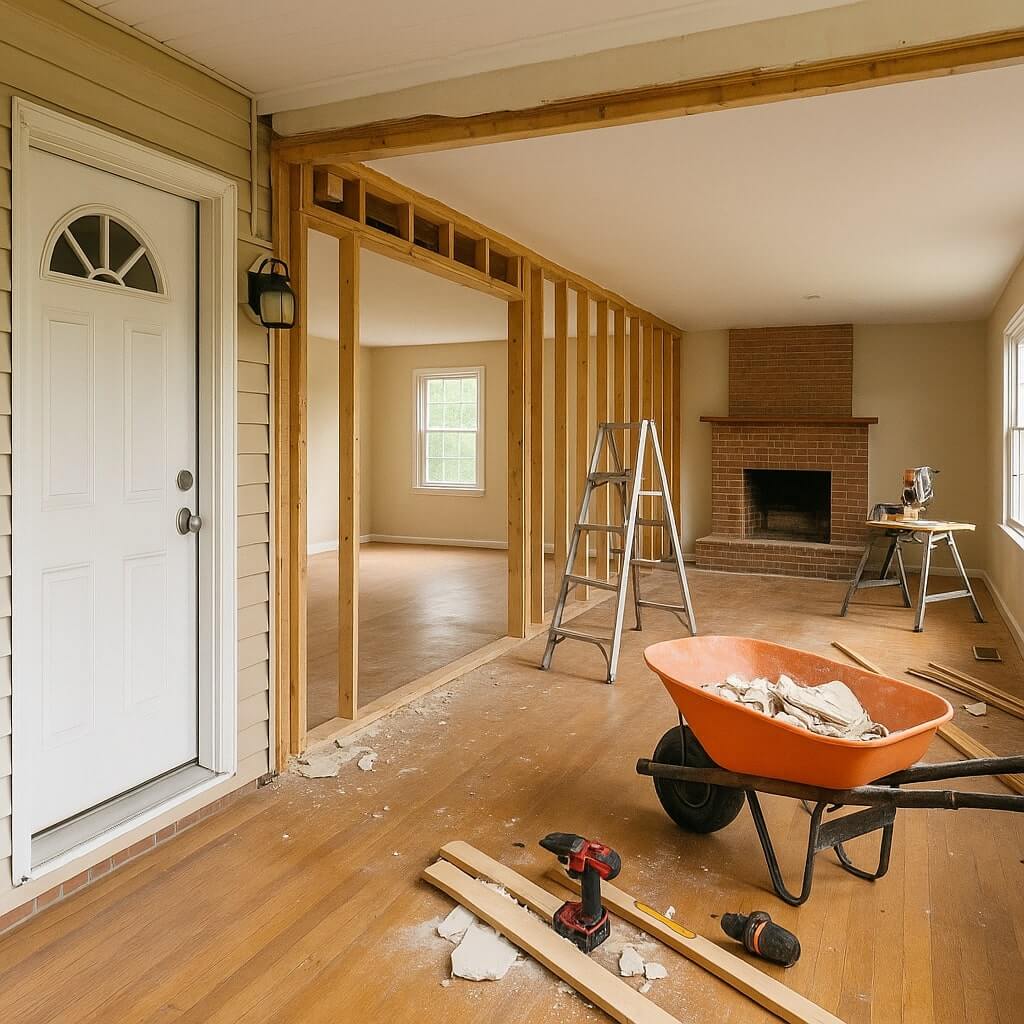When you’re starting on a home renovation, knowing essential terms can greatly impact your project’s success. From understanding what a load-bearing wall is to the importance of blueprints, these concepts are vital for effective communication with your contractor. You’ll also need to navigate permits and regulations. Let’s break down these key terms so you can approach your renovation with confidence and clarity. What’s the first term you need to know? Let’s find out.
Key Takeaways
- Understand the difference between renovation (updating aesthetics) and remodeling (changing layout or function) to make informed decisions.
- Familiarize yourself with essential construction terms like blueprint, framing, and punch list for effective communication with contractors.
- Identify load-bearing walls early in the project to maintain structural integrity and avoid costly mistakes during remodeling.
- Research local building codes and obtain necessary permits to ensure compliance and protect your investment throughout the renovation process.
- Establish a clear budget and timeline, prioritizing essential upgrades and maintaining open communication with stakeholders to prevent delays.
Understanding Renovation vs. Remodeling

When it comes to home improvements, understanding the difference between renovation and remodeling is essential.
The renovation definition involves restoring or updating a space, often focusing on aesthetics without altering its structure. For instance, painting walls or replacing flooring are typical renovations.
On the other hand, the remodeling definition entails changing the layout or function of a space, which may involve structural changes, such as moving walls or adding new rooms.
Knowing these distinctions helps you make informed decisions about your projects, ensuring you achieve your desired results and enhance your home’s value effectively.
What Is a Load-Bearing Wall?
A load-bearing wall is an essential structural component of your home, supporting the weight of the roof, floors, and upper stories.
These walls perform critical load bearing functions, which are fundamental for maintaining your home’s structural integrity. Without them, you risk compromising the stability of your entire house.
Identifying load-bearing walls typically involves checking the building’s blueprints or consulting a professional. If you plan to make renovations, it’s important to know which walls are load-bearing to avoid costly mistakes.
Always prioritize these walls during any remodeling projects to guarantee your home remains safe and secure.
The Importance of Blueprints
Understanding the importance of blueprints is essential for any home renovation project, as these detailed plans provide a roadmap for your renovations.
The significance of blueprints in home renovations cannot be overstated; they serve as a vital roadmap for your project.
The blueprint benefits are numerous, helping you visualize the final outcome and preventing costly mistakes.
Key blueprint components include:
- Accurate dimensions
- Material specifications
- Electrical and plumbing layouts
- Structural details
- Design elements
Having a thorough blueprint guarantees all parties involved are on the same page, streamlining communication and execution.
With a solid plan in hand, you’ll navigate the renovation process with confidence, ultimately transforming your vision into reality while avoiding unexpected setbacks.
Key Construction Terms to Know

Understanding key construction terms is vital for maneuvering your home renovation project successfully.
Familiarizing yourself with common terminology and essential industry acronyms can help you communicate effectively with contractors and guarantee you’re on the same page.
Let’s explore these terms so you can approach your renovation with confidence.
Common Construction Terminology
While starting a home renovation project, grasping common construction terminology can greatly streamline communication with contractors and guarantee a smoother process.
Familiarizing yourself with essential construction jargon and renovation terminology will empower you during discussions and decision-making.
- Blueprint: Detailed architectural plans.
- Framing: The structural skeleton of the building.
- Load-bearing wall: A wall that supports weight from above.
- Subfloor: The layer beneath the finished flooring.
- Punch list: A list of final touches needed before project completion.
Understanding these terms helps you navigate the renovation journey with confidence.
Essential Industry Acronyms
As you engage with contractors and professionals in the renovation field, you’ll encounter numerous industry acronyms that can enhance your comprehension and communication. Familiarizing yourself with these acronym definitions can save time and prevent misunderstandings.
For instance, “HVAC” stands for Heating, Ventilation, and Air Conditioning, while “ROI” means Return on Investment, vital for evaluating your project’s value. Other common terms include “RFI” (Request for Information) and “RFQ” (Request for Quotation).
Understanding this industry jargon not only streamlines discussions but also empowers you to make informed decisions throughout your renovation process. Stay ahead by mastering these essential acronyms!
Permits and Regulations Explained
When planning your home renovation, understanding the different types of permits is vital.
Local building codes can greatly impact your project, so it’s important to familiarize yourself with them.
You’ll also need to know the application process to make certain your renovation complies with all regulations.
Understanding Permit Types
Understanding the various types of permits is essential for any home renovation project, as these legal documents confirm your work complies with local regulations.
Different permits address specific tasks and guarantee safety and legality.
- Building Permit: Required for structural changes.
- Electrical Permit: Needed for any electrical work.
- Plumbing Permit: Necessary for plumbing alterations.
- Zoning Permit: Confirms compliance with land use regulations.
- Permit Application: Must be accurately completed to avoid delays.
Be mindful of permit expiration; you might need to renew before starting to avoid fines and complications in your renovation plans.
Local Building Codes
Local building codes serve as the foundation for safe and compliant home renovations, guaranteeing your project aligns with community standards.
These regulations dictate everything from structural integrity to electrical wiring, so you must familiarize yourself with them. Before starting any work, check with your local building department to determine what permits are required.
During your renovation, local inspections will verify that your project meets safety compliance guidelines. Ignoring these codes can lead to fines or unsafe conditions, so prioritize adherence for both legal and safety reasons.
A thorough understanding of local building codes protects your investment and guarantees peace of mind.
Application Process Overview
Before you can start your home renovation, you’ll need to navigate the application process for permits and regulations. Understanding these application requirements is essential to keeping your project on track.
- Research local building codes
- Gather necessary documentation
- Submit your application
- Pay applicable fees
- Anticipate potential revisions
These steps can greatly impact your project timeline, so don’t underestimate their importance.
Make sure you allow enough time for approvals and stay informed about any changes in regulations. By thoroughly preparing, you can streamline the process and minimize delays, making your renovation experience smoother and more efficient.
Different Types of Contractors
When starting on a home renovation project, knowing the different types of contractors available can greatly impact your experience and the outcome.
A general contractor oversees the entire project, managing subcontractor types for specialized tasks. Specialty contractors focus on specific areas like plumbing or electrical work, ensuring expertise in their field.
A general contractor manages the overall project, while specialty contractors bring expertise to specific trades like plumbing and electrical work.
When contractor hiring, check contractor licensing to verify credentials. Understand contractor agreements, which outline responsibilities and pricing.
Clear communication about contractor responsibilities can prevent misunderstandings. By choosing the right contractors, you’ll streamline your renovation process and achieve better results for your home.
The Role of an Architect
Choosing the right contractor is just one part of the renovation equation; an architect plays a pivotal role in bringing your vision to life. They specialize in architectural design and guarantee your project aligns with your aesthetic and functional needs.
Through effective project collaboration, architects transform ideas into practical solutions.
- Create innovative designs
- Maximize space efficiency
- Guarantee compliance with building codes
- Manage project timelines
- Oversee contractor performance
Hiring an architect not only elevates your renovation but also protects your investment by addressing potential challenges before they arise. Their expertise is invaluable for a successful outcome.
Understanding Materials and Finishes

Materials and finishes are the backbone of any home renovation, greatly influencing both aesthetics and functionality. When selecting materials, you’ll want to prioritize material durability, ensuring your choices withstand wear and tear over time.
For example, hardwood flooring offers longevity, while laminate can provide a budget-friendly alternative. Finish options further enhance your design; think about paint, stains, and sealants that protect surfaces and elevate visual appeal.
A matte finish might create a modern look, whereas a glossy finish can add sophistication. By balancing durability and aesthetic value, you’ll create spaces that not only look great but also stand the test of time.
Budgeting for Your Renovation Project
Selecting high-quality materials and finishes can profoundly impact your renovation budget.
To effectively manage your finances, consider the following:
To keep your renovation on track, establish a clear budget and timeline while prioritizing essential upgrades.
- Create a detailed cost estimation for materials and labor.
- Allocate a contingency fund for unexpected expenses.
- Define your renovation timeline to prevent costly delays.
- Prioritize essential upgrades over luxury items.
- Research and compare contractor bids to find the best value.
Conclusion
To summarize, grasping essential home renovation terms empowers you to communicate effectively with contractors and make informed decisions. By understanding key concepts like load-bearing walls, blueprints, and the importance of permits, you can navigate your renovation project with confidence. Familiarizing yourself with construction terminology and budgeting strategies guarantees you stay on track and meet your aesthetic goals. With this knowledge, you’re well-equipped to turn your renovation dreams into reality while guaranteeing compliance and efficiency throughout the process.




